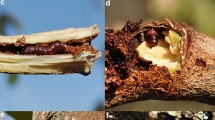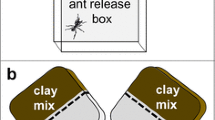Abstract
The size of underground ant nests positively correlates with their worker number, suggesting that during colony growth, workers respond to increased space demands by enlarging the existing nest. In leaf-cutting ants, the presence of brood and a growing symbiotic fungus are expected to generate spatial demands workers should respond to. We investigated to what extent the presence of in-nest stores, such as brood and fungus, and actual space availability influence the digging behavior of leaf-cutting ants and lead to the adjustment of nest enlargement. In the laboratory, we offered worker groups of Acromyrmex lundi a nest site consisting of either a tunnel, representing reduced available space, or a tunnel and a small chamber, representing ample available space as a starting point for nest enlargement. Workers could move and store offered brood and fungus into the nest structure, and enlarge it as needed. The presence of brood and fungus influenced digging activity as well as the architecture of the nest. In the presence of relocated brood, digging activity was higher in reduced space than in ample space, suggesting that high worker density stimulated excavation. When workers relocated fungus and brood into ample space, digging activity was similar as in their absence, yet a larger chamber and fewer tunnels were excavated. During the process of nest enlargement, workers were observed to initially excavate space in excess, which was refilled with part of the removed soil pellets, thus leading to a reduction of available space. Pellet deposition seemed to be opportunistic, with workers refilling unused space. Results indicate that the size of a leaf-cutting ant nest does not simply depend on the number of inhabiting workers. Rather, workers adjust the enlargement of their nest space depending on the current space available and the presence of in-nest stores.










Similar content being viewed by others
References
Antonialli WF, Giannotti E (2001) Nest architecture and population dynamics of the ponerine ant Ectatomma edentatum. Sociobiology 38:475–486
Autuori M (1942) Contribuição para o conhecimento da saúva (Atta spp. Hymenoptera–Formicidae). III. Excavação de um saúveiro (Atta sexdens rubropilosa Forel, 1908). Arq Inst Biol 13:137–148
Bollazzi M, Kronenbitter J, Roces F (2008) Soil temperature, digging behaviour, and the adaptive value of nest depth in South American species of Acromyrmex leaf-cutting ants. Oecologia 158:165–175. doi:10.1007/s00442-008-1113-z
Bollazzi M, Forti LC, Roces F (2012) Ventilation of the giant nests of Atta leaf-cutting ants: does underground circulating air enter the fungus chambers? Insect Soc 59:487–498. doi:10.1007/s00040-012-0243-9
Buhl J, Deneubourg JL, Grimal A, Theraulaz G (2005) Self-organized digging activity in ant colonies. Behav Ecol Sociobiol 58:9–17. doi:10.1007/s00265-004-0906-2
Camargo RS, Forti LC (2015) What is the stimulus for excavation of fungus chamber in leaf-cutting ants? Acta Ethol 18:31–35. doi:10.1007/s10211-014-0181-9
Camargo RS, Forti LC, Fujihara RT, Roces F (2011) Digging effort in leaf-cutting ant queens (Atta sexdens rubropilosa) and its effects on colony survival in the claustral phase. Insect Soc 58:17–22. doi:10.1007/s00040-010-0110-5
Camazine S, Deneubourg JL, Franks NR, Sneyd J, Theraulaz G, Bonabeau E (2001) Self-organization in biological systems. Princeton studies in complexity. Princeton University Press, Princeton
Chen J (2009) Automatic system for continuously monitoring digging volume of Red imported fire ants (Hymenoptera: Formicidae) in the laboratory. J Econ Entomol 102:1393–1395
Deneubourg JL, Franks NR (1995) Collective control without explicit coding: the case of communal nest excavation. J Insect Behav 8:417–432. doi:10.1007/BF01995316
Franks NR, Deneubourg JL (1997) Self-organizing nest construction in ants: individual worker behavior and the nest’s dynamics. Anim Behav 54:779–796. doi:10.1006/anbe.1996.0496
Franks NR, Wilby A, Silverman BW, Tofts C (1992) Self-organizing nest construction in ants: sophisticated building by blind bulldozing. Anim Behav 44:357–375
Fröhle K (2009) Mechanismen zur Regulierung der Nestgröße während des Koloniewachstums bei Blattschneiderameisen. PhD dissertation, Julius-Maximilians Universität Würzburg, Germany
Fröhle K, Roces F (2009) Underground agriculture: the control of nest size in fungus-growing ants. In: Theraulaz G, Solé R, Kuntz P (eds) From insect nests to human architecture - Workshop on engineering principles of innovation in swarm-made architecture. European Centre for Living Technology, Venice, pp 95–104
Fröhle K, Roces F (2012) The determination of nest depth in founding queens of leaf-cutting ants (Atta vollenweideri): idiothetic and temporal control. J Exp Biol 215:1642–1650. doi:10.1242/jeb.066217
Gordon DM, Paul RE, Thorpe K (1993) What is the function of encounter patterns in ant colonies? Anim Behav 45:1083–1100
Grassé PP (1959) La reconstruction du nid et les coordinations inter-individuelles chez Bellicositermes natalensis et Cubitermes sp. La Théorie de la stigmergie: Essai d’interprétation du comportement des termites constructeurs. Insect Soc 6:41–81
Halley JD, Burd M, Wells P (2005) Excavation and architecture of Argentine ant nests. Insect Soc 52:350–356. doi:10.1007/s00040-005-0818-9
Hangartner W (1969) Carbon dioxide, a releaser for digging behavior in Solenopsis geminata (Hymenoptera: Formicidae). Psyche 76:58–67
Hansell MH (1984) Animal architecture and building behavior. Longman Inc., New York
Hölldobler B, Wilson EO (1990) The ants. Harvard University Press, Berlin
Jacoby M (1936) Über das Wachsen des Atta-Nestes im ersten Jahre nach der Gründung (Hym. Formicidae). Rev Entomol 6:120–126
Jacoby M (1937) Das räumliche Wachsen des Atta-Nestes vom 50. bis zum 90. Tage (Hym. Formicidae). Rev Entomol 7:416–425
Jonkman JCM (1980a) The external and internal structure and growth of nests of the leaf-cutting ant Atta vollenweideri Forel, 1983 (Hym.:Formicidae) Part I. Z angew Entomol 89:158–173
Jonkman JCM (1980b) The external and internal structure and growth of nests of the leaf-cutting ant Atta vollenweideri Forel, 1983 (Hym.:Formicidae) Part II. Z angew Entomol 89:217–246
Mallon EB, Franks NR (2000) Ants estimate area using Buffon’s needle. Proc R Soc Lond B 267:765–770
Mikheyev AS, Tschinkel WR (2004) Nest architecture of the ant Formica pallidefulva: structure, costs and rules of excavation. Insect Soc 51:30–36. doi:10.1007/s00040-003-0703-3
Moreira AA, Forti LC, Andrade APP, Boaretto MAC, Lopes JFS (2004a) Nest architecture of Atta laevigata (F. Smith, 1958) (Hymenoptera: Formicidae). Stud Neotrop Fauna En 39:109–116. doi:10.1080/01650520412331333756
Moreira AA, Forti LC, Boaretto MAC, Andrade APP, Lopes JFS, Ramos VM (2004b) External and internal structure of Atta bisphaerica Forel (Hymenoptera: Formicidae) nests. J Appl Entomol 128:204–211
Moser JC (1963) Contents and structure of Atta texana nest in summer. Ann Entomol Soc Am 56:286–291
Pielström S (2013) On the role of local information in the spatial organization of collective nest digging in the leaf-cutting ant Atta vollenweideri (Forel, 1893). PhD dissertation, Julius-Maximilians Universität Würzburg, Germany
Pielström S, Roces F (2012) Vibrational communication in the spatial organization of collective digging in the leaf-cutting ant Atta vollenweideri. Anim Behav 84:743–752. doi:10.1016/j.anbehav.2012.07.008
Pielström S, Roces F (2013) Sequential soil transport and its influence on the spatial organization of collective digging in leaf-cutting ants. PLoS One 8:e57040. doi:10.1371/journal.pone.0057040
Pielström S, Roces F (2014) Soil moisture and excavation behaviour in the Chaco leaf-cutting ant (Atta vollenweideri): digging performance and prevention of water inflow into the nest. PLoS One 9:e95658. doi:10.1371/journal.pone.0095658
Pratt SC (2005) Quorum sensing by encounter rates in the ant Temnothorax albipennis. Behav Ecol 16:488–496. doi:10.1093/beheco/ari020
Pratt SC, Pierce NE (2001) The cavity-dwelling ant Leptothorax curvispinosus uses nest geometry to discriminate between potential homes. Anim Behav 62:281–287. doi:10.1006/anbe.2001.1777
Rasse P, Deneubourg JL (2001) Dynamics of nest excavation and nest size regulation of Lasius niger (Hymenoptera: formicidae). J Insect Behav 14:433–449. doi:10.1023/A:1011163804217
Römer D, Roces F (2014) Nest enlargement in leaf-cutting ants: relocated brood and fungus trigger the excavation of new chambers. PLoS One 9:e97872. doi:10.1371/journal.pone.0097872
Solomon SE, Lopes CT, Mueller UG, Rodrigues A, Sosa-Calvo J, Schultz TR, Vasconcelos HL (2011) Nesting biology and fungiculture of the fungus-growing ant, Mycetagroicus cerradensis: New light on the origin of higher attine agriculture. J Ins Sci 11:12. http://www.insectscience.org/11.12
Stahel G, Geijskes DC (1941) Weitere Untersuchungen über Nestbau und Gartenpilz von Atta cephalotes L. und Atta sexdens L. (Hym. Formicidae). Rev Entomol 12:243–268
Sudd JH (1969) The excavation of soil by ants. Z Tierpsychol 26:257–276
Sudd JH (1972) The response of digging ants to gravity. Insect Soc 19:243–250
Sudd JH, Franks NR (1987) The behavioral ecology of ants. Chapman and Hall, New York, pp 55–64
Toffin E, Di Paolo D, Campo A, Detrain C, Deneubourg JL (2009) Shape transition during nest digging in ants. P Natl Acad Sci USA 106:18616–18620. doi:10.1073/pnas.0902685106
Toffin E, Kindekens J, Denoubourg JL (2010) Excavated substrate modulates growth instability during nest building in ants. P Roy Soc Lond B Bio 277:2617–2625. doi:10.1098/rspb.2010.0176
Tschinkel WR (1987) Seasonal life history and nest architecture of a winter-active ant, Prenolepsis imparis. Insect Soc 34:143–164
Tschinkel WR (2003) Subterranean ant nests: trace fossils past and future? Palaeogeogr Palaeocl Palaeoecol 192:321–333
Tschinkel WR (2004) The nest architecture of the Florida harvester ant. Pogonomyrmex badius. J Ins Sci 4:21
Weber NA (1966) Fungus-growing ants. Science 153:587–604. doi:10.1126/science.153.3736.587
Acknowledgments
We would like to thank Kerstin Fröhle for sharing her experience with the laboratory methods to investigate ant digging behavior, and Steffen Pielström, James Waters, and two anonymous reviewers for their helpful comments and suggestions on the manuscript. Annette Laudahn and Adrienne Gerber-Kurz assisted with experimental preparation and were responsible for ant rearing. This study was partially supported by funds from the German Research Foundation (DFG, Grant SFB 554/TP E1).
Author information
Authors and Affiliations
Corresponding author
Electronic supplementary material
Below is the link to the electronic supplementary material.
Rights and permissions
About this article
Cite this article
Römer, D., Roces, F. Available space, symbiotic fungus and colony brood influence excavation and lead to the adjustment of nest enlargement in leaf-cutting ants. Insect. Soc. 62, 401–413 (2015). https://doi.org/10.1007/s00040-015-0419-1
Received:
Revised:
Accepted:
Published:
Issue Date:
DOI: https://doi.org/10.1007/s00040-015-0419-1




